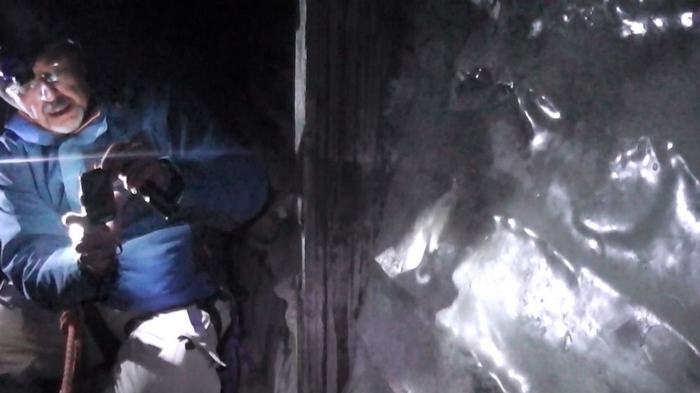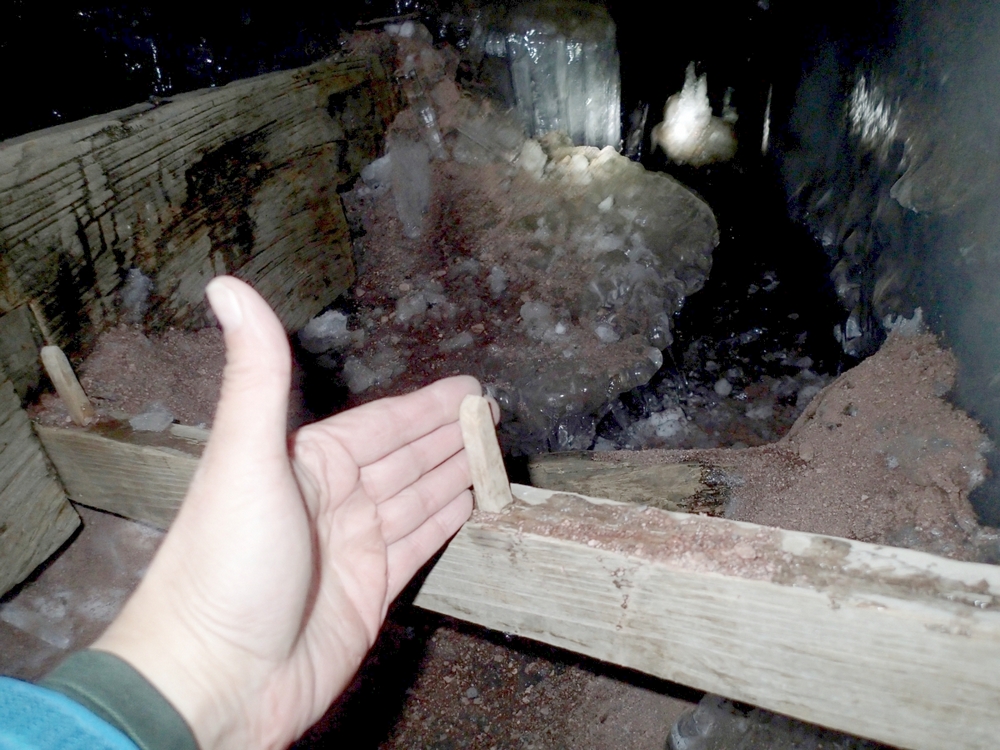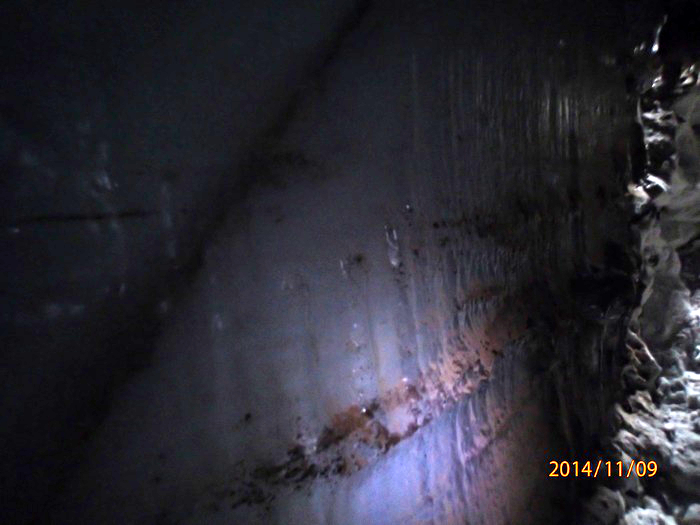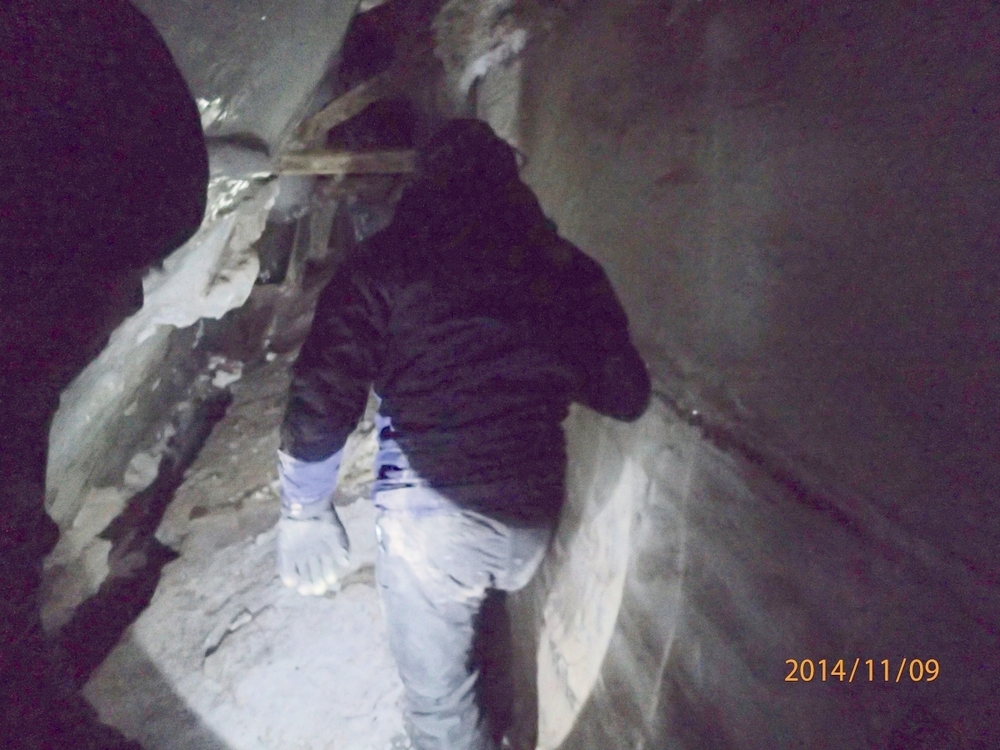Phillip Williams visited the NAMI site in 2014. He confirms the NAMI data and this is what he says:
 “……Now feeling well and fully aware of my surroundings, I move into position to descend into the passage. As we make our way down and through the long snow-covered ice tunnel, I notice the passage turning toward a level floor. I loose one of my crampons along the descent. The floor now turning level, it doesn’t much matter.
“……Now feeling well and fully aware of my surroundings, I move into position to descend into the passage. As we make our way down and through the long snow-covered ice tunnel, I notice the passage turning toward a level floor. I loose one of my crampons along the descent. The floor now turning level, it doesn’t much matter.
Shining our flashlights to my left, I see several pieces of worked wooden boards sticking out from the floor and wall. I take off my gloves so as to operate the camera. I use my other hand as a measure.  Photo: Philip Williams
Photo: Philip Williams
For the miles before reaching High Camp until I notice those first well-finished wooden boards, I had seen nothing on this mountain but rocks, snow, and ice. Ahead and behind us and on every side lay a monotonous menagerie of smooth-sided broken rocks either completely or partially covered by snow and ice.
As we shine our lights further down the passage where we are walking, that scene suddenly changes. As our flashlights survey the end of the tunnel, I see a long passage between two walls that narrows towards the top. The wall to our left slants outward as it reaches the floor with worked wooden pieces sticking out here and there.
I am astonished by the very high, very straight, and very long wall to our right. Wide horizontal boards are visible behind a thick coating of ice. The wall appears bowed slightly inward as one looks towards the bottom. What seems to be a wooden floor covered with ice is remarkably level all along the passage. The walled passage extends as far as our flashlights can reach into the darkness.
“What to make of this underground cathedral!” Or might it be a giant warehouse?
Peering to my right at what appears a straight though slightly bowed hull, I say to myself: “It might also be a great ship.”
 I move quickly from place to place, aiming to record with my camera the most interesting features and structures. I see several exposed mortise and tenon joints, the boards apparently having broken free from their original placement. I also notice many square pegs having broken free from the square holes that once contained them.
I move quickly from place to place, aiming to record with my camera the most interesting features and structures. I see several exposed mortise and tenon joints, the boards apparently having broken free from their original placement. I also notice many square pegs having broken free from the square holes that once contained them.
I see no evidence of nails or any metal used for fastening the boards, though it seems that the builder had to use metal tools to cut and work the boards. ….. the guides restrain me from climbing over what appears a wooden brace in front of our passage so as to head deeper along what appears a bowed wall. The translucent ice seem to reveal the blackened wall that I had noticed from the photograph of this site taken a few years ago. The entire wall is constructed of long, wide, straight horizontal boards.
We look at the edge of the floor to our left. Cracks along the wall reveal a large compartment below. The guides point to a similar compartment above our heads.
The guides tell us that we have entered the structure’s second level. I want to stay, to study, and record, but …we also have to get off the mountain while it is still light. ….
Know that two American witnesses report that: our eyes have seen, our hands have touched, our cameras have recorded a wooden structure of what appear several large floors buried under many tons of volcanic rock and ice above 4000 meters on the south side of Greater Mount Ararat. The local villagers have believed it to be Noah’s Ark since the earthquake of 1840 unveiled it. Whatever this is, it is hardly of recent fabrication. It could never have been constructed in situ at this deep and dangerous site where we visited it. It is deserving of the most serious archaeological and scientific study. “
Photos by: Philip Williams, used here with permission